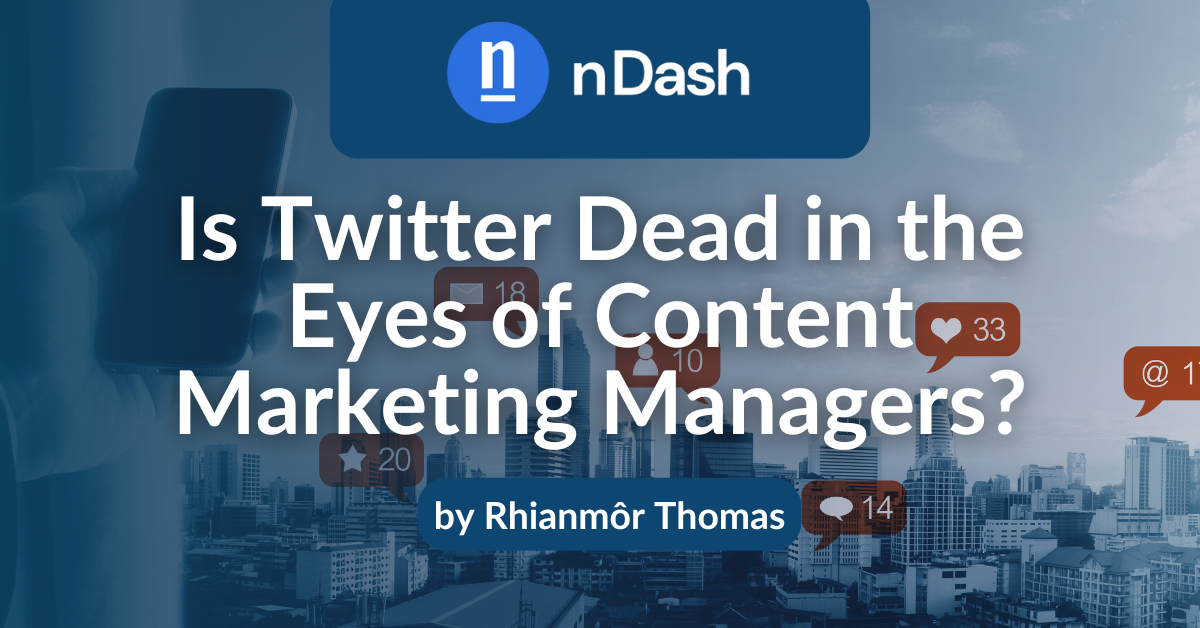Twitter/X has undergone significant transformations that have impacted user engagement and advertiser confidence. Since its acquisition, X has faced declining engagement, a significant rebrand, and major shifts in its policies. Concerns over these changes have led to the question of whether the platform still holds relevance in content marketing. Content marketing managers have watched these changes closely and are re-evaluating X’s role in their strategies. This blog explores how these shifts impact content marketing and whether X remains a valuable tool.
The Current State of Twitter/X for Content Marketing Managers
It’s hardly a secret that X has experienced difficulties since Elon Musk’s acquisition and the subsequent changes to the platform. These changes have included rebranding, policy shifts, and layoffs, all of which have affected user engagement. The new developments have resulted in a reduced audience for content marketers, challenging their ability to engage with users effectively.
Rebranding and Platform Changes
In July 2023, over the course of one weekend, Twitter’s entire identity changed. It was now completely rebranded as “X.” The logo, name, and overall intention of the company were all different, which was surprising for such a well-established brand. This alarmed many content marketers who rely on the platform’s familiar identity as part of their social media strategy.
Prior to this change, Twitter was designed for real-time communication and interactions through microblogging. Users shared thoughts, news, and information through posts limited to 280 characters and hashtags. The brief, concise content was easily consumed and, therefore, an effective marketing tool for businesses.
Now, ‘X’ is intended to become an “everything” app—similar to the WeChat platform used by billions in China. It effectively functions as its own operating system, fulfilling user needs, including digital payments, food deliveries, news, entertainment, and more.
This shift has alienated many users and marketers who appreciated Twitter’s original identity.
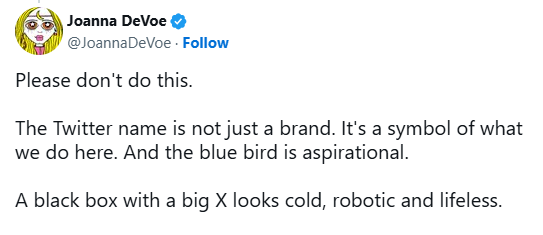
Changes accompanying the rebrand have complicated X’s user experience and marketing dynamics. New subscription-based features have restricted accessibility and undermined Twitter’s egalitarian ethos.
Some of the changes affecting day-to-day use include:
- A rate limit on the number of posts different account tiers could read each day. (6,000 for paying users and 600 for non-paying users)
- Paid monthly subscription in order to receive a verification check.
- A rollback of moderation rules
- The reinstatement of 60,000 accounts that had been formerly banned for breaking the platform’s rules
These shifts are leading brands to question whether this new environment aligns with their values.
Impact on User Engagement
X has experienced a troubling drop in user engagement since its rebrand. By the start of 2024, reports showed a 15% drop in global monthly active users. There was an 18% decrease in the U.S. alone. App downloads dropped by 38% globally, as concerns like moderation issues and increased hate speech had a major effect.
This reduced user engagement poses a fundamental challenge for content marketers who rely on user participation to build brand visibility. By mid-2024, major brands like Apple, IBM, and Disney halted their ads on the platform. As a result, X—a platform heavily reliant on advertising income—experienced a nearly 60% drop in U.S. ad revenue.
Evaluating Twitter’s Value for Content Marketing Managers
Twitter’s appeal to content marketers has traditionally stemmed from its role in organically building brand visibility and establishing thought leadership. However, with these aspects now under pressure, content marketing managers must ask if Twitter’s unique strengths are diminishing as “X.”
X has transformed some of the platform’s original features valued by content marketers, creating both opportunities and challenges:
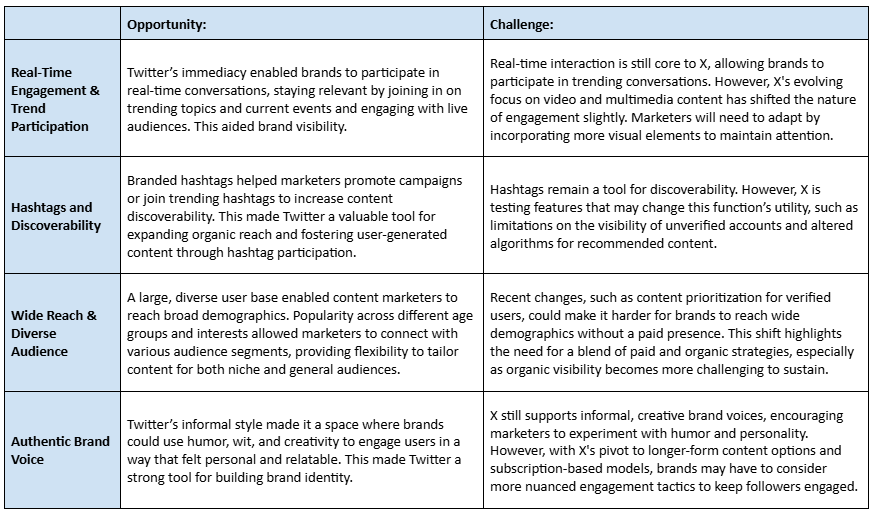
With the recent election, “X” has also become highly politicized. This has raised risk concerns for brands about engaging on the platform without potentially alienating entire segments of their audience.
Twitter’s Role in Brand Visibility and Thought Leadership
For years, Twitter enabled brands to amplify their reach and connect with users through trending topics, direct engagement, and real-time conversation. This was particularly effective for companies positioning themselves as thought leaders, where timely insights on trending topics became imperative.
Since the rebrand, some aspects of this dynamic have been altered. For many, the departure from the Twitter brand identity has diminished its appeal as a focused, real-time information network. Industry experts note that many established users feel alienated. The removal of free verification and changes to the platform’s policies now make it less effective for organic engagement.
This shift is driving users to competitors like LinkedIn and emerging platforms such as Meta’s Threads. These platforms are increasingly being seen as viable alternatives for professional networking and thought leadership visibility.
The Shift to Other Platforms
Content marketing managers are redirecting efforts to other platforms as engagement and achieving measurable ROI have become challenging on X. Due to challenges around brand safety, diminished reach, and unpredictable content policies, marketers are hesitant to commit ad budgets to X.
According to Kantar’s 2024 Media Reactions report, nearly 26% of marketers intend to reduce spending on X. Platforms like YouTube, TikTok, and Amazon are seeing increases due to higher perceived brand safety and better engagement potential. This indicates a desire among marketers to find stability on platforms that prioritize similar values to those Twitter once held.
Content Performance on Twitter/X: Metrics and Trends
Current performance metrics reveal significant declines in reach and engagement rates. Content marketers are forced to re-evaluate previously successful strategies.
Engagement Decline Across Twitter/X
Recent data highlights significant engagement declines on X, marking a shift from past metrics. In 2023, X’s overall engagement rate fell by nearly 20% as brands and users re-evaluated their investment in the platform.
Marketers have also observed a drop in the frequency of posts by brands. Declining from an average of 3.9 posts per week in 2022 to 3.31 in 2023. The lower posting rate has likely influenced user interaction levels. This effect is compounded by a 6% drop in brand presence on X as marketers reconsider ROI amid engagement declines.
Many brands report skepticism regarding their ability to achieve positive returns on X. Only about 30% are currently confident in positive ROI outcomes from the platform—a significant drop from previous years.
Algorithms and Content Visibility
Recent algorithm changes have further limited organic content visibility on Twitter/X, especially for non-verified users. The new model favors paid subscribers, placing a barrier to visibility that discourages many from engaging without a financial commitment. For marketers, these changes create obstacles, as organic reach was one of Twitter’s most valuable assets for cost-effective brand exposure.
One key aspect is an intensified focus on in-network content. Users now primarily see posts from accounts they already follow, limiting reach for branded content aimed at attracting new followers. The platform’s new ranking algorithms prioritize tweets with rich media alongside content marked as “relevant” based on a user’s prior interactions.
Personal connections and interests are favored over broad-reach marketing campaigns. This shift can result in lower engagement and impressions for brands that rely heavily on text-based or informational posts.
Moreover, visibility filters and content fatigue algorithms limit exposure to certain types of repetitive content. This means that brand posts seen as overly promotional or lacking engagement may receive reduced visibility in users’ feeds. This focus on engagement metrics makes it challenging for brands to maintain consistent reach without investing in paid advertising.
Many content marketing managers are now weighing whether these adjustments align with their goals. Lower organic reach may no longer justify the time and resources traditionally invested in Twitter/X.
The Future of Twitter/X in Content Marketing Strategy
Content marketing managers are reassessing Twitter/X’s role in their strategies, and they are concerned about significant shifts in platform identity and functionality. Many are diversifying their efforts across multiple platforms while cautiously continuing to leverage Twitter/X until a clear replacement emerges.
Balancing Twitter with Other Platforms
As the Twitter rebrand has demonstrated, a social platform can change overnight. To avoid singular dependency on potentially turbulent social channels, marketers need to diversify and build a presence across multiple platforms.
Many content marketing managers are reallocating resources to platforms with stable reach metrics and less volatile policy changes. Adopting a multi-platform approach that includes LinkedIn, Instagram, and YouTube can act as insurance against Twitter/ X’s unpredictable changes. Ultimately, content marketing managers are adapting their strategies and diversifying to maintain consistent engagement across platforms.
Emerging Alternatives and Diversification
Bluesky has also emerged as an intriguing alternative as content marketers explore new platforms for user engagement and brand visibility. Founded by former Twitter CEO Jack Dorsey, Bluesky aims to give users greater control and decentralized moderation policies.
Although Bluesky is still in its beta phase with limited access, it has gained a community that values ethical content moderation. As of 2024, it is operating on an invite-only basis, translating to a relatively smaller user base. This, along with limited advertising capabilities, means it doesn’t yet provide the reach and ROI needed for large-scale marketing campaigns.
However, many brands are interested in establishing an early presence, especially those targeting tech-savvy and socially conscious demographics. Bluesky is a promising platform to watch.
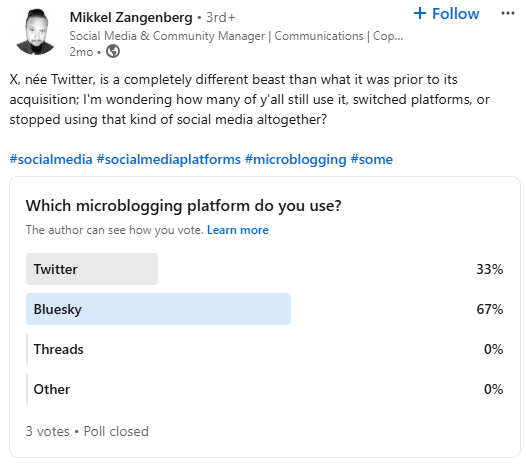


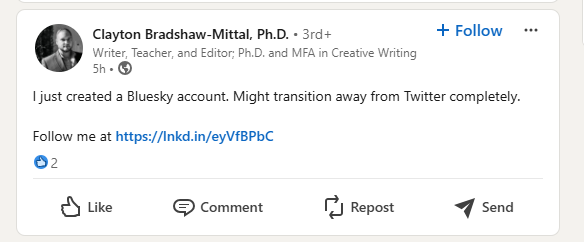
According to Tim Bajarin, a leading consumer technology consultant and analyst, Substack Notes is another potential alternative and one to watch.

Anecdotal Evidence from Industry Voices
Content marketers are expressing reservations about X’s new direction, emphasizing the platform’s increasingly unpredictable environment. Jenny Li Fowler, director of social media strategy at MIT, observes more professionals, experts, and organizations are making LinkedIn their primary platform. While they are not fully leaving Twitter/X, it appears LinkedIn is becoming the choice platform for organic, in-the-moment conversations. Ultimately, though, 82% of content marketers are still on Twitter/X, preserving it as a viable platform heading into 2025.
Key Takeaways and Sentiment Trends
A common sentiment among content marketers is emerging. While Twitter/X still has potential, it requires cautious, strategic use rather than the full investment it once commanded. Many are adopting a wait-and-see approach, supplementing their presence on Twitter/X with efforts on other platforms.
Business Insider says that Twitter users worldwide are expected to decrease by 5.1% in 2025. The platform’s new focus on video is a departure from its initial value as a microblogging platform. This will likely affect related strategies, as it will become similar to Instagram or YouTube instead of its original niche.
LinkedIn is becoming the preferred platform for professional networking and organic conversations. While YouTube and TikTok are favored for their higher engagement rates, especially among younger demographics. Overall, content marketers are adopting a more diversified approach. Aiming to balance their presence across multiple platforms to mitigate risks associated with X’s unpredictable future.
Content Marketing Managers and Twitter/X’s Uncertain Future
Content marketing managers are divided on Twitter/X’s future. Some see it as a dying platform due to declining engagement, policy changes, and the shift to paid subscriptions. Whereas others believe it still holds potential for specific campaigns, particularly with real-time engagement.
Ultimately, user trends will be the deciding factor, as they dictate where marketers will find them. Overall, Twitter/X is still seen as a viable option heading into 2025. However, content marketers are proceeding with caution, prioritizing diversification over any one singular platform.
About the Author: Rhianmôr Thomas

I am a freelance writer living in Los Angeles. With an undergraduate in Screenwriting and an MBA, I write for a variety of mediums.
Most days, you can find me working on client blogs, articles, website copy, product descriptions, and more. Currently, I write on a range of topics, specializing in B2B & B2C marketing, fashion, film, social media, higher education, and ecommerce.
I always aim to write copy that makes the reader think – about a better way to do something, the future of an industry or just about their opinion on the topic. When you can blend the goals of the client with the ability to make the intended (or unintended!) audience think – that’s successful copywriting.
To learn more about Rhianmôr, check out her writing profile here: Rhianmôr Thomas
